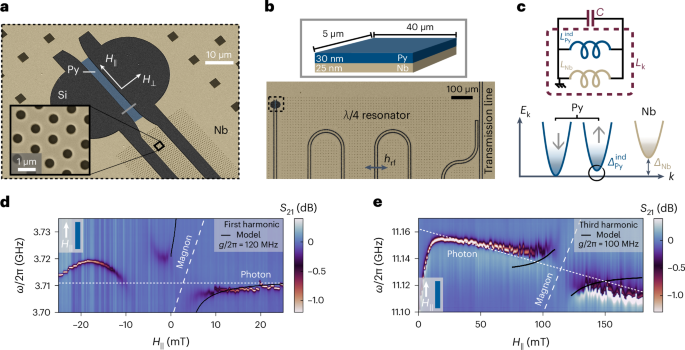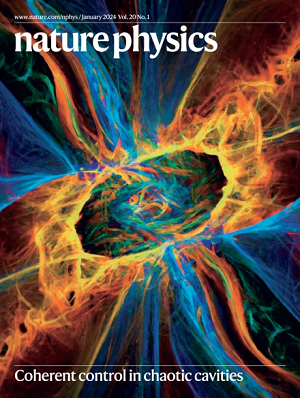电路量子电动力学探测混合超导体-铁磁体双层中的诱导双倍各向异性配对
IF 17.6
1区 物理与天体物理
Q1 PHYSICS, MULTIDISCIPLINARY
引用次数: 0
摘要
混合系统是非常规超导研究的前沿领域之一,也是实现拓扑超导态的前景广阔的平台。由于这些材料的介观尺寸,使用许多传统测量技术对它们进行探测具有挑战性,因此需要新的实验探针才能成功表征它们。在这里,我们展示了一种探针,它能让我们利用电路量子电动力学的微波技术测量微米级超导体的超流体密度。我们将这一技术应用于超导体-铁磁体双层膜,并发现在样品平面内,近距离诱导的超流体密度是两倍各向异性的。它还表现出幂律温度缩放,表明了结点超导状态。这些实验结果与理论预测的具有结点 p 波阶参数的诱导三重配对特征一致。此外,我们还观察到微波响应在铁磁共振频率附近的变化,这表明自旋动力学与铁磁层中的诱导超导阶之间存在耦合。我们的实验技术可以被更广泛地应用,例如研究范德华异质结构等低维材料中脆弱的非常规超导性。本文章由计算机程序翻译,如有差异,请以英文原文为准。


Circuit quantum electrodynamics detection of induced two-fold anisotropic pairing in a hybrid superconductor–ferromagnet bilayer
Hybrid systems represent one of the frontiers in the study of unconventional superconductivity and are a promising platform to realize topological superconducting states. These materials are challenging to probe using many conventional measurement techniques because of their mesoscopic dimensions, and therefore require new experimental probes so that they can be successfully characterized. Here, we demonstrate a probe that enables us to measure the superfluid density of micrometre-size superconductors using microwave techniques drawn from circuit quantum electrodynamics. We apply this technique to a superconductor–ferromagnet bilayer and find that the proximity-induced superfluid density is two-fold anisotropic within the plane of the sample. It also exhibits power-law temperature scaling that is indicative of a nodal superconducting state. These experimental results are consistent with the theoretically predicted signatures of induced triplet pairing with a nodal p-wave order parameter. Moreover, we observe modifications to the microwave response at frequencies near the ferromagnetic resonance, suggesting a coupling between the spin dynamics and induced superconducting order in the ferromagnetic layer. Our experimental technique can be employed more widely, for example to study fragile unconventional superconductivity in low-dimensional materials such as van der Waals heterostructures. Heterostructures of ferromagnets and superconductors may host exotic superconducting states. Now a circuit quantum electrodynamics technique is demonstrated that provides evidence for triplet p-wave pairing in such a heterostructure.
求助全文
通过发布文献求助,成功后即可免费获取论文全文。
去求助
来源期刊

Nature Physics
物理-物理:综合
CiteScore
30.40
自引率
2.00%
发文量
349
审稿时长
4-8 weeks
期刊介绍:
Nature Physics is dedicated to publishing top-tier original research in physics with a fair and rigorous review process. It provides high visibility and access to a broad readership, maintaining high standards in copy editing and production, ensuring rapid publication, and maintaining independence from academic societies and other vested interests.
The journal presents two main research paper formats: Letters and Articles. Alongside primary research, Nature Physics serves as a central source for valuable information within the physics community through Review Articles, News & Views, Research Highlights covering crucial developments across the physics literature, Commentaries, Book Reviews, and Correspondence.
 求助内容:
求助内容: 应助结果提醒方式:
应助结果提醒方式:


